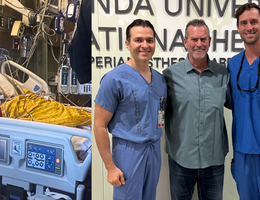
LLUMC’s TAVR care team members gathered on May 15 to celebrate the milestone of 1,000 procedures.
Physicians at Loma Linda University Medical Center (LLUMC) have completed 1,000 TAVR (transcatheter aortic valve replacement) procedures, the first Inland Empire-based medical center to reach the milestone as of May 8.
TAVR is an alternative procedure to open-heart surgery for treating a common heart valve disease known as aortic stenosis, in which the narrowing of the aortic valve restricts normal blood flow from the heart. Experts can replace the diseased heart valve with a new one during the minimally invasive procedure in under an hour. According to the American Heart Association, 2 in 10 older Americans have this disease, which can cause chest pain, dizziness, shortness of breath, and fatigue.
Upon FDA’s approval of TAVR for high-risk patients in 2011, LLUMC care teams strategized to launch a program, says Anthony Hilliard, MD, chief of cardiology at Loma Linda University International Heart Institute. While he says LLUMC’s heart team had been performing interventional procedures to implant stents for decades, TAVR was transformative because it enabled fixing the most disease-prone heart valve without opening up patients’ chests.
Hilliard says it proved challenging to assemble resources and coordinate schedules between multidisciplinary team members needed for TAVR: cardiologists, cardiothoracic surgeons, anesthesiologists, nurses, nurse practitioners, imaging specialists, technicians, and program coordinators.
“It takes a strong, cohesive team to achieve something like launching and maintaining a TAVR program,” Hilliard says. “To see how the program has evolved is very gratifying.”
Since the first TAVR performed at LLUMC in October 2013, hundreds of patients have checked into the hospital for this life-saving procedure. The FDA initially approved TAVR for high-risk patients who were not candidates for surgical valve replacement due to age, physical condition, comorbidities, or other factors. With the mortality for aortic stenosis being worse than most cancers — over 50% mortality within two years — Hilliard says high-risk patients were left without options before TAVR.
“It was worth the risk at the time because it granted patients a good quality of life for several more years,” he says.
TAVR has since expanded to treat the full spectrum of patients, from high to low risk, says Jason Hoff, MD, medical director of the structural interventional program at International Heart Institute. Many advancements in equipment and technology have enhanced the overall TAVR experience for patients. For instance, physicians now perform TAVR with patients under conscious sedation instead of general anesthesia. The artificial heart valve device has become smaller, sleeker, and improved to create a better seal once inserted in the heart, thus resulting in better outcomes.
Hoff says the benefits of TAVR compared to open-heart surgery include less risk of complications, less pain, and a speedier recovery — with most patients getting discharged the next day and returning to regular activity within a week. As of 2019, more aortic valves have been replaced via transcatheter than surgical means in the U.S., Hoff says. In addition, he says TAVR paved the way for transcatheter procedures to replace and repair other heart valves, including the mitral and tricuspid valves.
“In a short amount of time, one lifespan, the field of structural interventional cardiology has exploded, and it continues to grow incredibly rapidly," Hoff says.
“The celebration of the thousandth TAVR performed at LLUMC is really a celebration of its whole history,” Hoff says. “We are continuing to build off the shoulders of giants who started the program, using a team-oriented, patient-first approach to keep growing the program's success in helping as many patients as possible.”
At Loma Linda University International Heart Institute, physicians are committed to providing patients with personalized and comprehensive cardiovascular care. To learn more, please visit lluh.org/heart-vascular or call 909-558-7717 to make an appointment.

